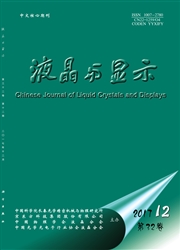

 中文摘要:
中文摘要:
一种新型有机电致发光二极管的阳极结构,在玻璃衬底上以半透明的A1膜为出光面,通过在空穴注入层(HAT-CN)和空穴传输层(NPB)中间插入三氧化钼(MoOa)层,制备了底发射微腔OLEDs。所制备的器件结构为Glass/A1(15nm)/HArr-CN(10nm)/MoOa(-znm)/NPB(30nm)/Alqa(70nm)/LiF(1nm)/A1(150nm)。通过电流密度一电压一亮度性能说明该结构有利于降低驱动电压和增强器件亮度。器件的最高亮度可以达到14390ed/m2,起亮电压为3.4V左右。设计的空穴型器件证明了该器件结构具有很好的空穴注入和传输特性。研究了光谱窄化和峰值偏移的微腔效应。
 英文摘要:
英文摘要:
A novel anode structure of organic light-emitting diodes was fabricated by inserting a molybdenum trioxide (MoOa) layer into the interface of hole injection layer(HIL) 1,4,5, 8,9, 11-hexaazatriphenylene-hexacarbonitrile (HAT-CN) and hole transport layer 4, 4-bis [N-(1-naphthyl)-N-phenylamino]biphenyl (NPB). The microcavity OLED with a 150 nmthick A1 top cathode and a transparent A1 bottom anode on a glass substrate was fabricated. It has the configuration of Glass/A1(15 nm)/HAT CN(10 nm)/MoOa (x nrn)/NPB(30 nm)/ Alqa (70 nm)/LiF (1 nm)/Al(150 nm). The current density-voltage-luminance(J-V-L) performances shows that this structure is beneficial to the reduction of the driving voltage and the enhancement of the luminance. The highest luminance of the device is reached to 14 390 cd/m2 at 13 V, with a turn-on voltage of 3. 4 V. "Hole only'devices were fabricated to verify the enhancement of hole injection and transport properties of this structure. The optical characteristics of the microcavity, such as narrowed and peak shift, were examined
 同期刊论文项目
同期刊论文项目
 同项目期刊论文
同项目期刊论文
 Electroluminescence enhancement in blue phosphorescent organic light-emitting diodes based on differ
Electroluminescence enhancement in blue phosphorescent organic light-emitting diodes based on differ Aluminum/MoO3 anode thin films: An effective anode structure for high-performance flexible organic o
Aluminum/MoO3 anode thin films: An effective anode structure for high-performance flexible organic o Properties of Phosphorescent Organic Light-Emitting Diodes with Different Doping Order on Light Emit
Properties of Phosphorescent Organic Light-Emitting Diodes with Different Doping Order on Light Emit A New Non-Contact Method Based on Relative Spectral Intensity for Determining Junction Temperature o
A New Non-Contact Method Based on Relative Spectral Intensity for Determining Junction Temperature o Cathode Formed by Thermal Evaporation of Ba:Al Alloy and Estimations of Barrier Height in an Organic
Cathode Formed by Thermal Evaporation of Ba:Al Alloy and Estimations of Barrier Height in an Organic 期刊信息
期刊信息
